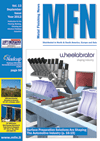E-Archive
Good Vibrations
in Vol. 13 - September Issue - Year 2012
Combined Controlled Shot Peening And Vibratory Super-Polishing = IOS Finishing




Fig. 1: After precision grinding and before shot peening, the peaks and valleys are inconsistent typically Ra 0.79

Fig. 2: After controlled shot peening the peaks and valleys are consistent, although rougher, typically Ra 1.5

Fig. 3: After super-polishing, peaks are removed only micro pockets/dimples remain, typically Ra 0.046
Combining the benefits of two proven technologies creates a perfect low Ra surface finish that improves the resistance of scuffing of the mating components, uniformly retaining lubricant while optimising excellent fatigue strength.
The combined process is called IOS and is especially applicable to high performance gears in the aerospace and motor sport industries as well as other precision engineered components that operate under high stress conditions.
While it is well known that shot peening increases resistance to fatigue failure and provides other benefits, tests have shown that the uniform surface that a controlled shot peening process creates is a perfect condition for a subsequent super-polishing process that is conducive to high performance, low operating temperatures, and retention and uniform flow of an even layer of lubricant.
High performance motor sport components such as bearings, gears, camshafts, cam-followers etc. normally require very low Ra surface finishes, but polishing to an absolute "glass" like surface would not be acceptable as some lubricant retention is key to temperature control and prevention of wear, so lubricants are designed to control temperature, minimise wear and friction, as in an F1 engine, uniform distribution of the lubricant is vital, some would say it is the engines lifeblood as it protects critical components and prevents power loss caused by deprivation of contact surfaces, likewise, aerospace engine bearings and gears operate in extreme conditions where the same surface finishing lubrication criteria applies.
Many advances have been made in the development of lubricants to operate and perform in high stress and high temperature conditions. If the mating interface surfaces of the components have a low Ra with extremely fine pockets (dimples) that are uniform and consistent, the correct amount of lubricant will be retained and distributed, performance and life of the engine is increased, and scuffing is greatly reduced.
Typically, the surface of a high performance component before shot peening and super-polishing is inconsistent, as the peaks and the valleys vary in height and depth (see Fig. 1).
Shot peening alone will not produce the required Ra surface, and vibratory finishing alone will not necessarily provide the stress relieving qualities of the shot peening process, and in order to truly uniformly reduce the deep valleys, the vibratory process time can be excessive.
When the parameters of the shot peening process are precisely controlled (shot size, shot type, blast velocity, media flow etc.) a surface condition is created that has uniform peaks and valleys (see Fig. 2). This means that before the components are treated in the vibratory super-polishing process, the surface finish is reasonably uniform but importantly the valleys are consistent in depth, which means that the micro pockets remaining after the super-polishing process are perfect for lubrication retention and flow distribution (see Fig. 3).
Both stages of the IOS process will maintain any critical component geometry and dimensions.
It is very important to add that both the shot peening and super-polishing stages must be precisely controlled, as conventional shot blasting and vibratory finishing processes will not produce the required surface and will result in excessive stock removal.
Depending on the material of the components to be IOS finished and the surface finish required, either a Keramo® paste type process or a chemically accelerated process is applied; both create an "Isotropic" surface. The geometry and the power of the vibratory finishing machine is also a key factor in achieving the desired finish.
|
Applications |
|
Aero-engine gears, bearings |
|
Motor sport, camshafts, cam-followers etc. |
|
Wind turbine gears |
|
Helicopter gears |
|
Can be applied to Motor sport and aerospace component overhaul |
|
And more |
|
Advantages |
|
Higher performance / Increased power efficiency |
|
Scuffing reduction |
|
Precision lubrication / Reduced operating temperatures |
|
Increased fatigue life / Increase component life |
|
Noise reduction |
|
No detrimental effect to critical dimensions |
Good Vibrations
by Paul Rawlinson
Contributing Editor MFN & Business Development Manager, Aerospace International for Rösler
Tel. +49.9533.924 647
Fax +49.9533.924 601
E-mail: P.Rawlinson@rosler.com




























